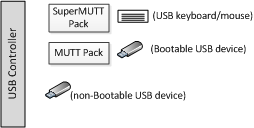Summary :
USB 3.0 drivers are the important elements to guarantee the normal running of the USB ports on your computer. If they are missing, outdated, or corrupt, you need to fix them by installing or updating them. MiniTool Software tells you how to fix USB drivers issues through doing these things in this post. You can read this post to get some useful information.
Jun 10, 2020 After plugging a USB device into your machine, expand the “Universal Serial Bus controllers” list in Device Manager. Click on the “USB Serial Converter” and open the USB Serial Converter properties. Enable the VCP Driver loading by opening the “Advanced” tab within the USB Serial Converter properties. Find your USB device which should be highlighted in green with a device type of “Mass Storage”, right click on it and select Speed Test (Ctrl+T). Click Start Test and it will sequentially read and write a 100MB file to get the scores. I would like to obtain by a command prompt a list of all USB devices connected to my computer (O.S. I've googled to find such a command, but all results seems useless to me or worse wo.
What Are USB 3.0 and USB 3.0 Drivers on Windows 10?

USB 3.0 is the third major version of the Universal Serial Bus (USB) standard for interfacing computers and electronic devices. It is one of the most popular and useful USB standard due to its fast and universal performance. You can find it on almost all modern devices.
To make sure that the USB 3.0 can work normally, you need to your computer has installed the right USB 3.0 drivers. If the USB 3.0 drivers on Windows 10 are outdated, missing or corrupt, the USB port will not work. In a situation like this, you will need to update or install USB driver Windows 10.
In this post, we will show you how to install or update USB 3.0 drivers on your Windows 10 computer.
USB thinks it’s a CD drive? Can’t access files on that drive? Before formatting the USB to normal, use MiniTool Power Data Recovery to recover its data.
How to Install USB 3.0 Drivers on Windows 10?
If the USB 3.0 drivers are missing or corrupt, you need to install the USB drivers Windows 10 to make everything back to normal.
Here is a step-by-step guide:
1. Search for Device Manager using the Windows search box and select the first search result.
2. Go to the Universal Serial Bus controllers section and unfold it.
3. Right-click on the USB Root Hub (USB 3.0) option and select Uninstall device.
4. Close Device Manager and reboot your computer.
After rebooting, Windows will automatically install the latest version of the USB 3.0 driver.
Are you troubled by USB keeps disconnecting and reconnecting Windows 10 issue? Do you want to solve it immediately? Read this post to get the solutions.
How to Update USB 3.0 Drivers on Windows 10?
Perhaps, you need to update USB drivers Windows 10. You need to follow these steps:
1. Use the same method mentioned above to open Device Manager.
2. Go to Universal Serial Bus controllers > USB Root Hub (USB 3.0).
3. Right-click on USB Root Hub (USB 3.0) and select Update driver.
4. Select Browse my computer for driver software to continue.
5. Select Let me pick from a list of available drivers on my computer and press Next.
6. Select USB Root Hub (USB 3.0) and press Next.

The updating process will start. When the process ends, you can close the update interface, Device Manager, and then restart your computer.
At times, the USB 3.0 driver issues may not be solved by using the above two methods. If so, you can then modify the USB power settings to fix the USB 3.0 drivers.
How to Modify the USB 3.0 Power Settings on Windows 10?
Drivers Bioage Testing Usb Devices For Windows 10
An improper USB power setting may be conflicted with the USB ports and connected devices. You can follow these steps to change the Windows 10 USB 3.0 power settings:

Drivers Bioage Testing Usb Devices Adapter

- Open Device Manager.
- Go to Universal Serial Bus controllers > USB Root Hub (USB 3.0).
- Right-click on USB Root Hub (USB 3.0) and go to Properties.
- Switch to the Power Management section.
- Check Allow the computer to turn off this device to save power.
Drivers Bioage Testing Usb Devices Software
Then, you can go to check whether the USB 3.0 driver issue is solved.

Comments are closed.